Lower Body Strength Training for Swimming
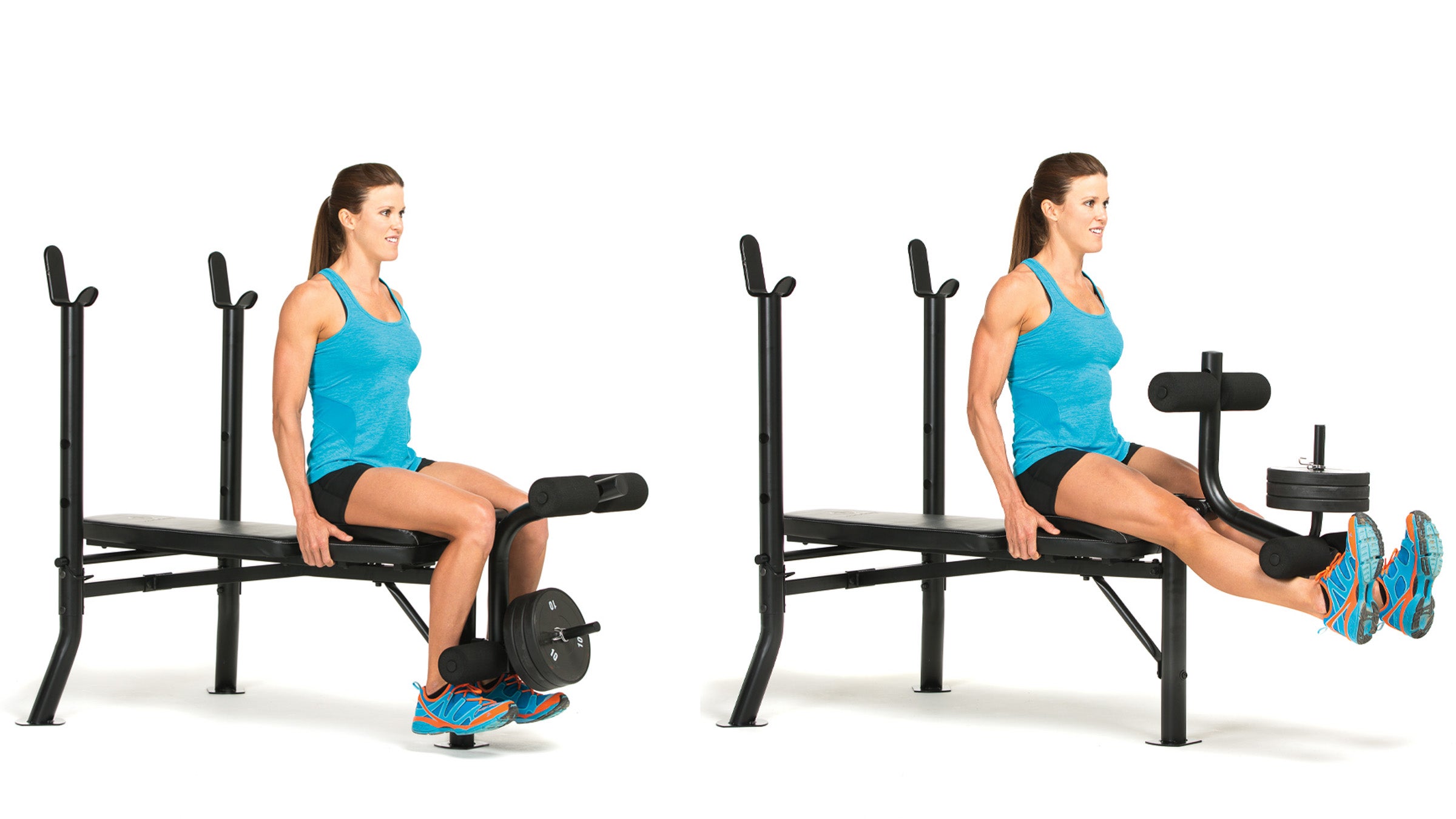
(Photo: Jeff Nelson)
Target Areas
Triathlon is an endurance sport, plain and simple. So why should you consider strength training a necessary part of a triathlon workout? The short answer is that strength training makes muscles stronger, and stronger muscles can perform longer at higher intensities before they fatigue.
Say you have a really cool muscle car, but it came with a tiny four-cylinder engine, so it doesn’t go very fast or have much power. You take it to the repair shop, where the basic engine is replaced with a big, strong V8 engine. Now you can speed along as fast as you like and have plenty of power to pass slower cars. Your body is just like the muscle car. If you keep the same body but change the engine that moves it, so that it’s stronger and has more power, then your athletic performances will improve and you will be passing slower competitors. Strength training creates a more powerful engine than if you were to rely on endurance training alone.
RELATED: Strength Training for Triathletes
Although the upper body may be the powerhouse during swimming, the lower body provides a good deal of propulsion and stability in the water. During your swim training you probably do drills that focus on just the upper or the lower body, which is why you need to do strength training that focuses on each part as well. The lower body, which includes your hips, thighs, and calves, doesn’t provide a lot of buoyancy, so you have to keep it moving during the swim to prevent dragging your legs along at the expense of your arms. Strength training for the lower body won’t provide a huge increase in your swimming speed or performance, but you will see its effects when you transition to the bike and run, where your legs are most important.
Lower-body strength training for swimming focuses on the glute muscles (gluteus maximus and medius), which extend your hip to the back and side; the hamstrings, which help with hip extension; the adductor group, which is responsible for keeping your legs close together; the quadriceps, which are strong knee extensors and hip flexors; and the calves, which point the feet and toes.
Lower Body Strength Training for Swimming
Targeting Problem Areas
Discover what areas your lower body strength program should concentrate on.
| Symptom | Cause | Solution |
| You have to rest your legs periodically and rely more on your arms. | Relatively weak lower body. | Strengthen your quads, glutes, and hips. |
| One leg becomes more tired than the other. | Muscular imbalance in legs. | Incorporate more single-leg exercises. |
Cable Lateral Lift
Muscle Focus: gluteus medius
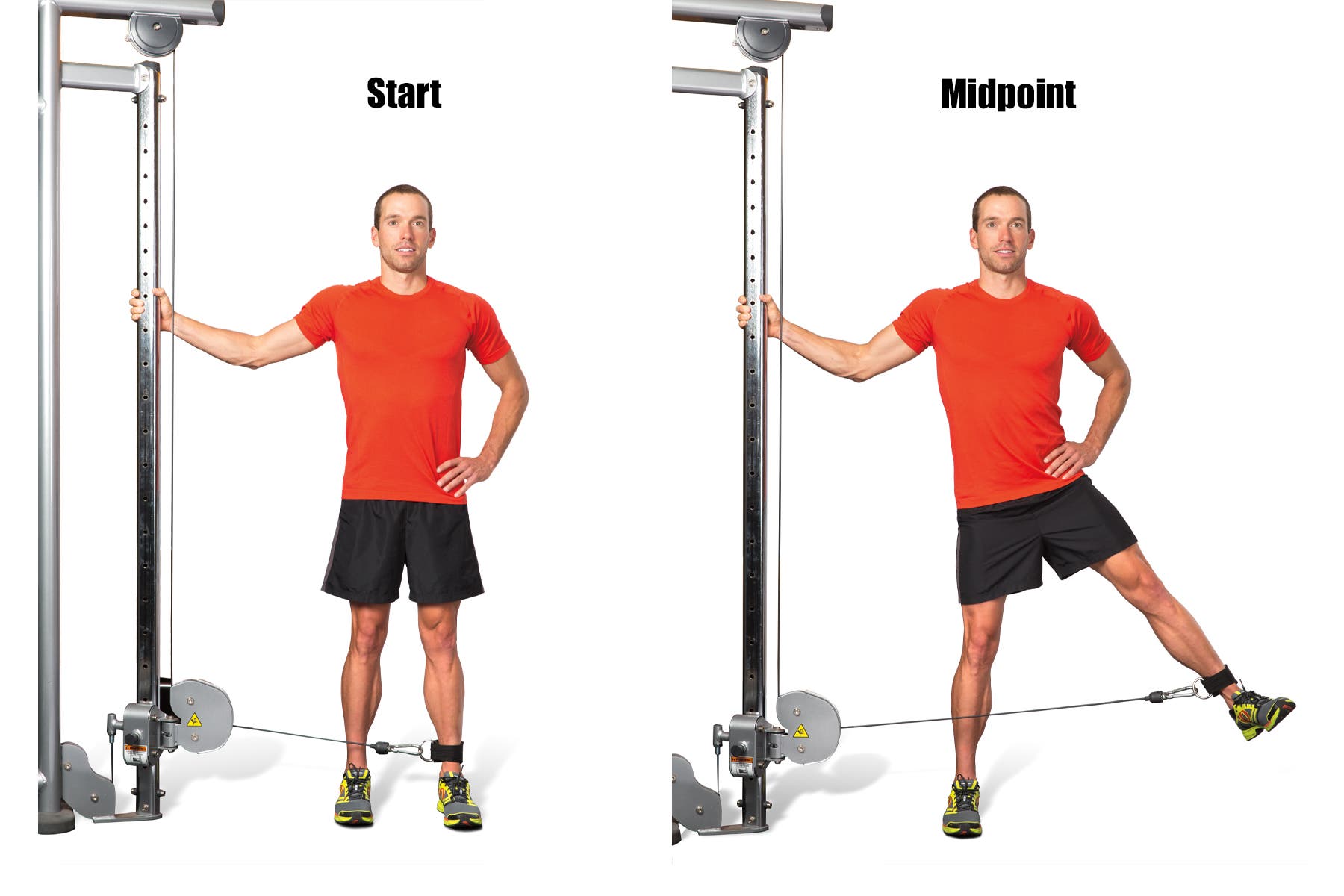
Photo: Jeff Nelson
The cable lateral lift focuses on the often-ignored smaller glute muscle, the gluteus medius. This muscle is responsible for lifting your leg out to your side and for stabilizing the larger gluteus maximus during hip extension. Training this muscle will help keep your legs from flailing out to the sides and will allow you to concentrate on extending your hip with each kick.
Attach the ankle strap of a low-pulley machine to one leg. Stand so that the leg you are going to work is farthest away from the machine and the cable crosses in front of you. Hold on to the machine with one hand and place the other hand on your hip (see start).
Keep your body as straight as possible while you lift your leg directly out to the side as high as you can (see midpoint). Concentrate on moving your leg to the side and not forward or backward. If you start to lean your upper body toward the machine, that’s as high as you can go; leaning doesn’t work the glute muscles. Slowly bring your leg back down and repeat until your reps are complete, then switch sides and do the same number of reps to complete your set.
Inclined Superman
Muscle Focus: gluteus maximus, hamstrings
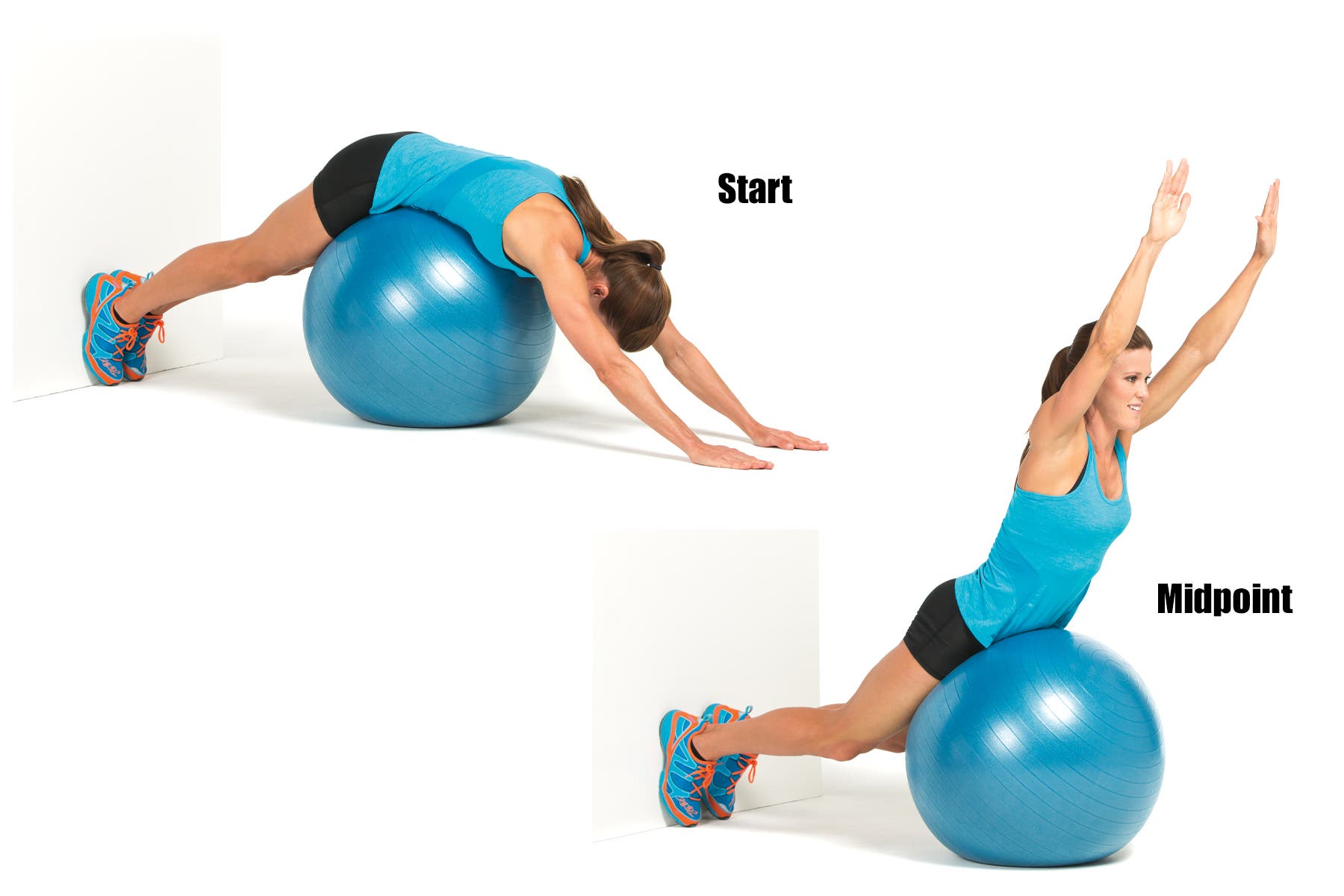
Photo: Jeff Nelson
The inclined superman locks your knees straight while you use your glutes and hamstrings to extend your hips. By keeping your knees locked, you are able to make the hamstrings work at the hip, effectively increasing the force of hip extension during your kick.
Facing away from a wall, lie facedown over your stability ball. Anchor your feet by setting your toes on the floor and your heels against the wall. Keep your legs straight. Position the ball so that the top is at your waist and your head is lower than your hips. Hold your arms straight out over your head, touching the floor (see start).
Take a deep breath, then exhale as you lift your upper body off the ball as high as you can (see midpoint). Your upper legs and hips will stay on the ball. Really focus on squeezing your glutes, and if you feel this in your lower back, that’s normal; those muscles are supporting your upper body. Slowly relax back to the start position, then repeat. If you need more resistance, hold a medicine ball in your hands.
Leg Extension
Muscle Focus: quads
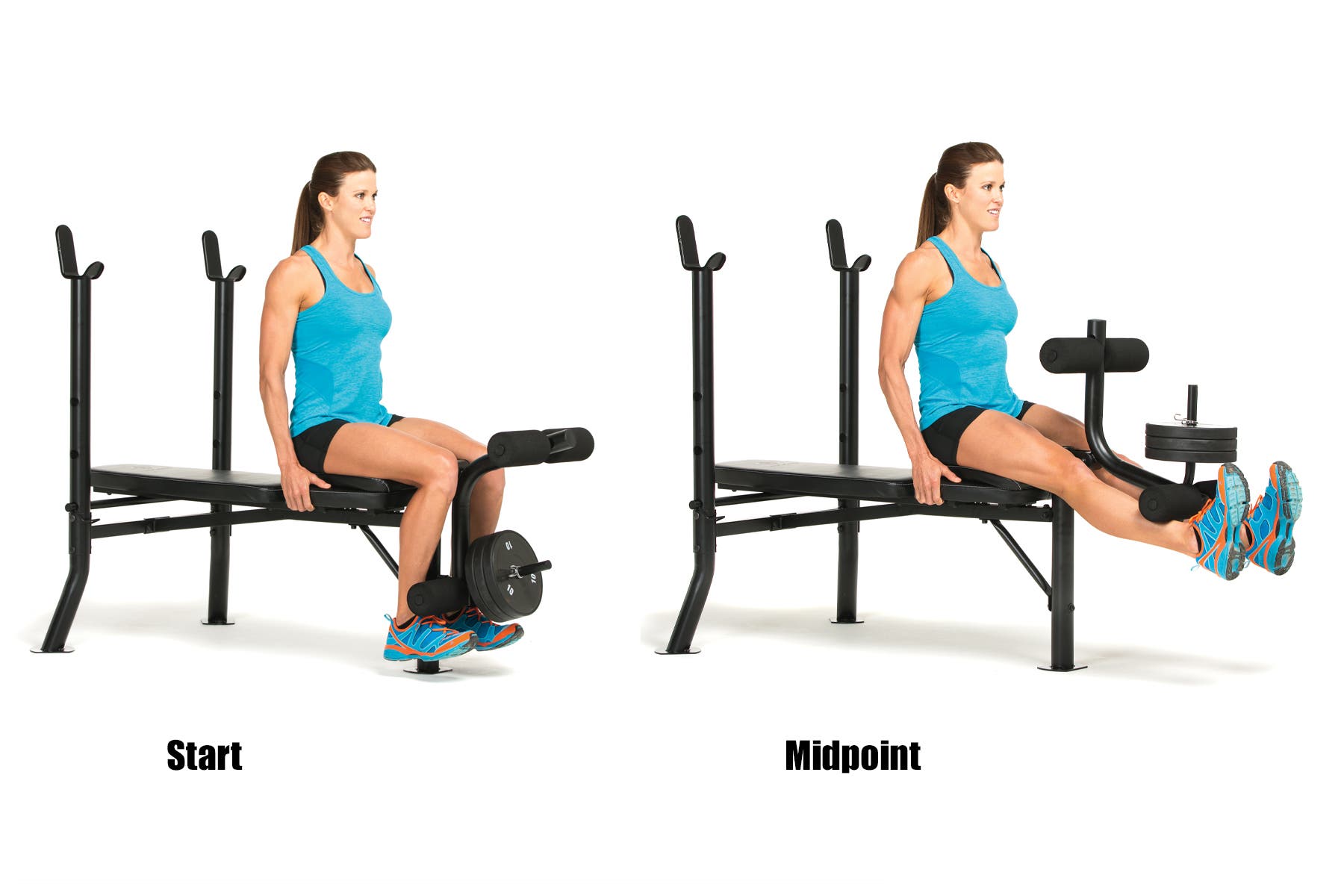
Photo: Jeff Nelson
This exercise concentrates on the force that you produce while extending your knees, which is critical for a solid kick. The leg extension machine has a bad rap as an exercise that will hurt your knees. There is minimal evidence for this, and it usually involves people who have had a previous knee injury. If your knees hurt, don’t do this exercise, but if they are healthy, performing it correctly should not cause any damage.
Sit down on the leg extension machine and line up your knees with the machine’s pivot point. On some machines, this requires adjusting the seat back. The pivot point is usually evident (or can be found on the machine’s instruction card) and is usually at the edge of the seat. If your knees are too far forward, there will be a lot of strain on them at the start of the exercise. Place your feet behind the footpad and adjust it so the pad rests just above your feet on your shins (see start). (Some machines adjust themselves, so you may not have to do this.) If you can adjust how far under the seat the leg pad is, move it so that you start with your knees bent at about a 90-degree angle. Too tight an angle at the start can cause some knee pain, especially if you have had a knee injury.
Holding onto the handles or sides of the seat, straighten out your legs as far as possible. The goal is to get your legs completely extended (see midpoint). Slowly lower your legs back down to a point just before the weight stack comes to a rest, then repeat until your set is complete.
Caution: If your knees hurt at all during this exercise, skip it.
Cable Hip Extension
Muscle Focus: gluteus maximus, hamstrings
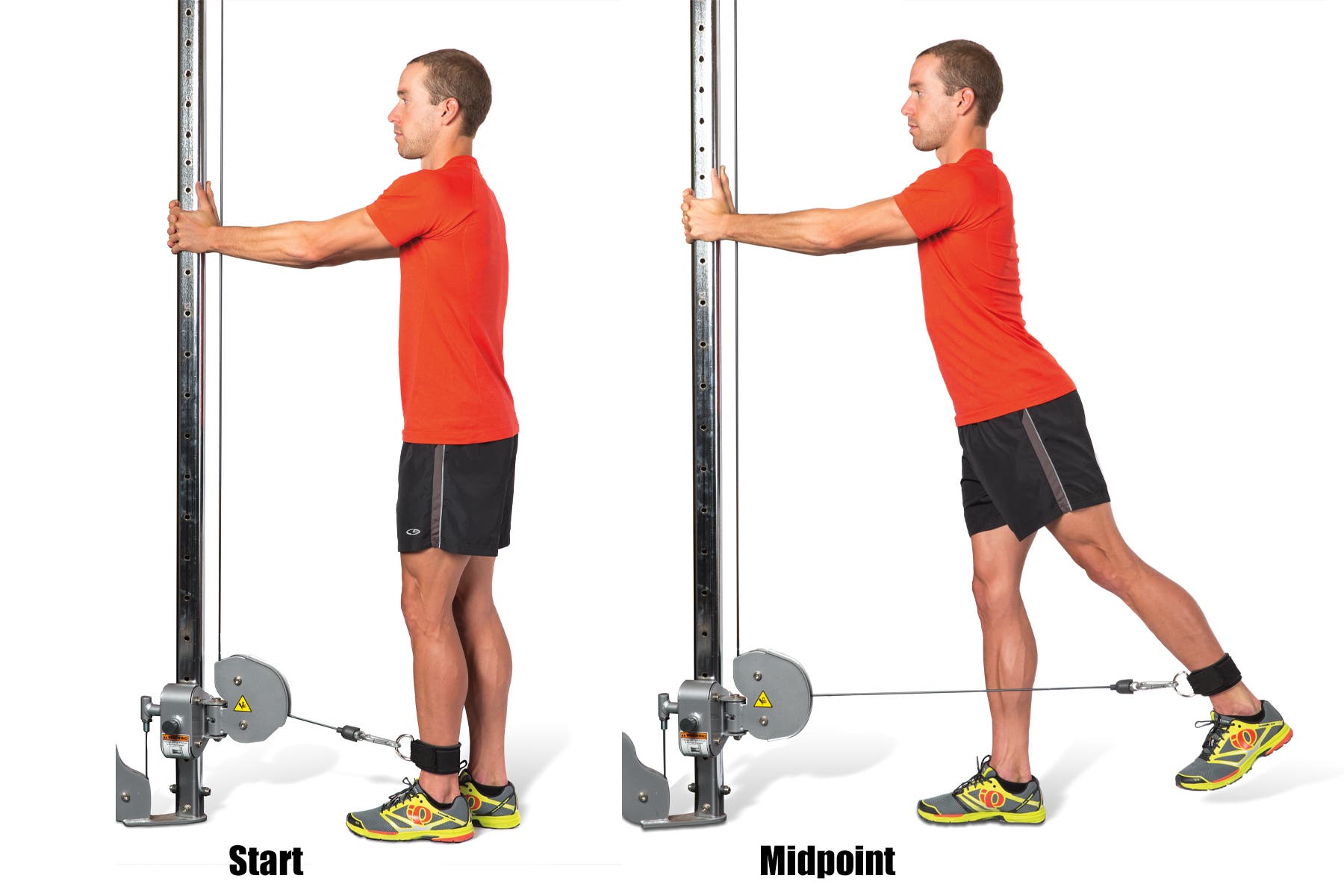
Photo: Jeff Nelson
The cable hip extension allows you to work through the same range of motion that the hip uses during swimming. You can alter the range of motion you use here to fit you best.
Attach the ankle strap of a low-pulley machine to one leg. Stand facing the machine and hold on to it with both hands. Step back until your arms are straight and there is just a little pull on the cable. Put all your weight on your support leg and keep your body as upright as possible (see start).
Keeping your leg straight, push it back as far as you can (see midpoint). This is not a large motion, so focus on squeezing your glutes. You may be tempted to lean your body forward to get more range of motion, but this actually decreases the effectiveness of the exercise. Slowly return to the start position, then repeat until your reps are complete. Switch legs and do the same number of reps on the opposite side to complete your set.
Cable Lateral Cross
Muscle Focus: adductors
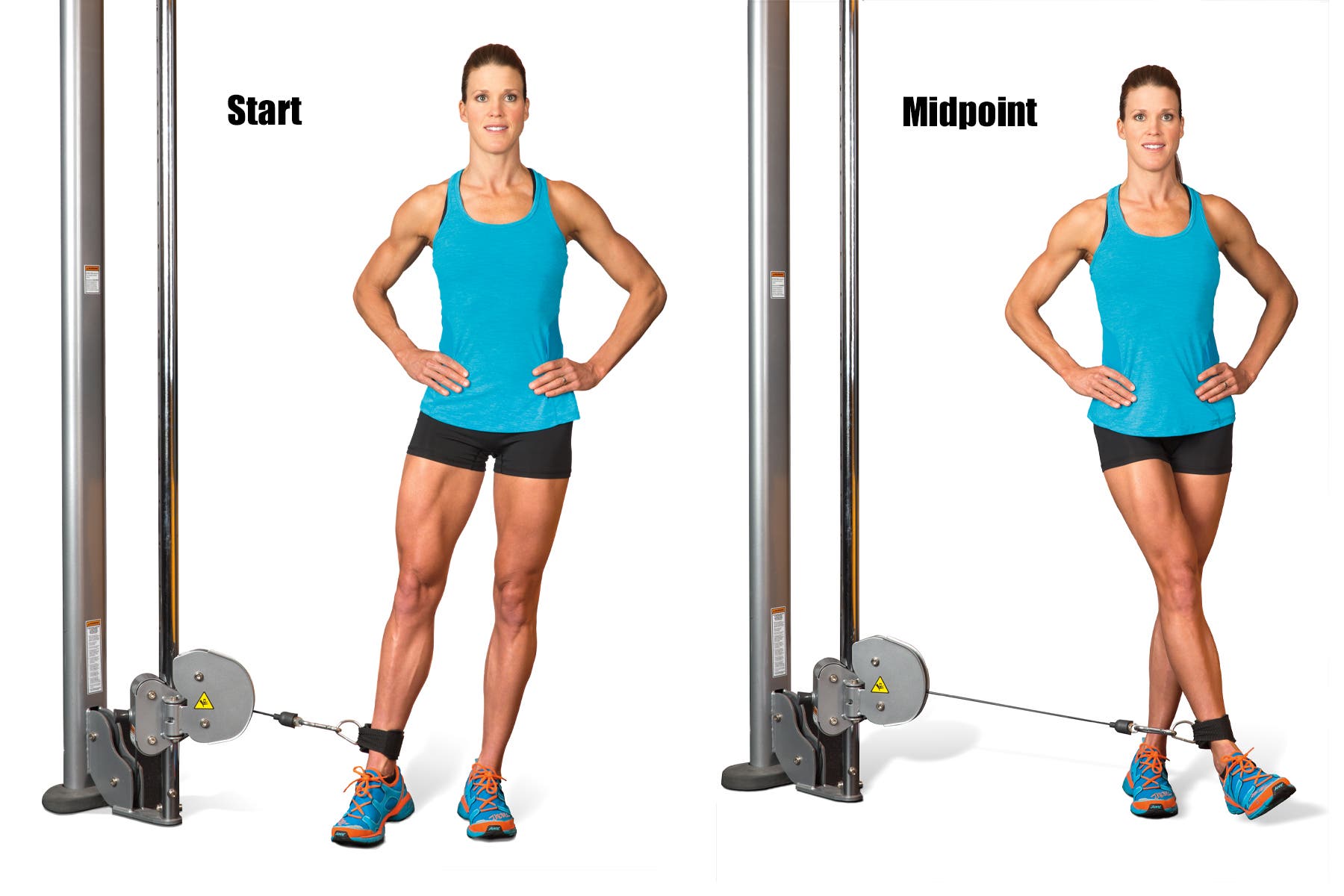
Photo: Jeff Nelson
The adductor muscles used during the cable lateral cross are responsible for helping the gluteus medius stabilize the hip and the gluteus maximus. Performing this exercise will also help with your hip extension force by keeping the leg moving in the correct direction.
Attach the ankle strap of a low-pulley machine to one leg. Stand so that the leg you are going to work is closest to the machine. Place both hands on your hips and step away from the machine until your working leg is being pulled toward it (see start). Put all your weight on the other leg. If you feel off balance, hold on to the machine with one hand.
Pull your extended leg back toward your support leg and then across in front of you as far as possible (see midpoint). As you move, make sure that the only part of you that is moving is your leg. Don’t let your shoulders or hips turn toward the machine in an effort to move your leg farther. Slowly return back to the start position, then repeat until your reps are complete. Switch legs and complete the same number of reps on the opposite side to complete your set.
Lying Leg Curl
Muscle Focus: hamstrings

Photo: Jeff Nelson
The lying leg curl mimics the position of swimming better than other leg curl exercises. Though you are not bending your knees that much during swimming, the hamstring muscles cross both the knee and hip joint, so they aid in moving your leg at the hip during the recovery phase of your kick.
Find the pivot point of the lying leg curl machine. Usually it is right at the edge of the padding. Stand at the end of the bench with your knees right against the padding and lie facedown. Your kneecaps should hang off the end of the bench and line up with the machine’s pivot point. Lie all the way down and hold on to the handles. (Some machines have pads for your elbows to rest on; others have a flat bench to rest your chest and head on. Either is fine.) Your feet should be underneath the leg pad (see start). Some machines adjust this automatically, but if yours does not, adjust the pad so it is in contact with the backs of your legs, just below your calves (on your Achilles tendon), and is not pushing on your foot.
Bend your knees, pulling the foot pad up as far as you can (see midpoint). The goal is to get the pad all the way to your buttocks. The farther you can curl your legs, the more you benefit from this exercise. Try to keep your hips flat on the pad during the motion. If they start to rise, hold them down by tightening your glutes. Slowly lower the weight back down, then repeat until your set is complete.
Seated Calf Raise
Muscle Focus: calves

Photo: Jeff Nelson
The seated calf raise mainly works the smaller calf muscle, the soleus. This muscle is a very strong endurance-oriented muscle that keeps your feet pointed while swimming. Sit down on the machine and place your feet on the footplate so that just the balls of your feet are on the plate and your heels are hanging off the back. Slide your knees under the pads and adjust them so they are snug against your knees but not pushing down hard (see start). You can hold on to the hand grips, but make sure not to pull the knee pad up with your hands during the exercise—that job must be done by your calves.
Push on the balls of your feet to raise your heels as high as you can (see midpoint). On the first rep, the bar that supports the machine will move out of the way. Lower your heels as far as you can to get a good stretch. When you can’t go down any farther, push back up on the balls of your feet to get back to the highest point you can reach. Repeat, lowering and raising your heels until you have finished all your reps. On the last rep, when you are at the highest point of the exercise, move the support bar back under the machine and lower the bar back down on it.
Standing Calf Raise
Muscle Focus: calves
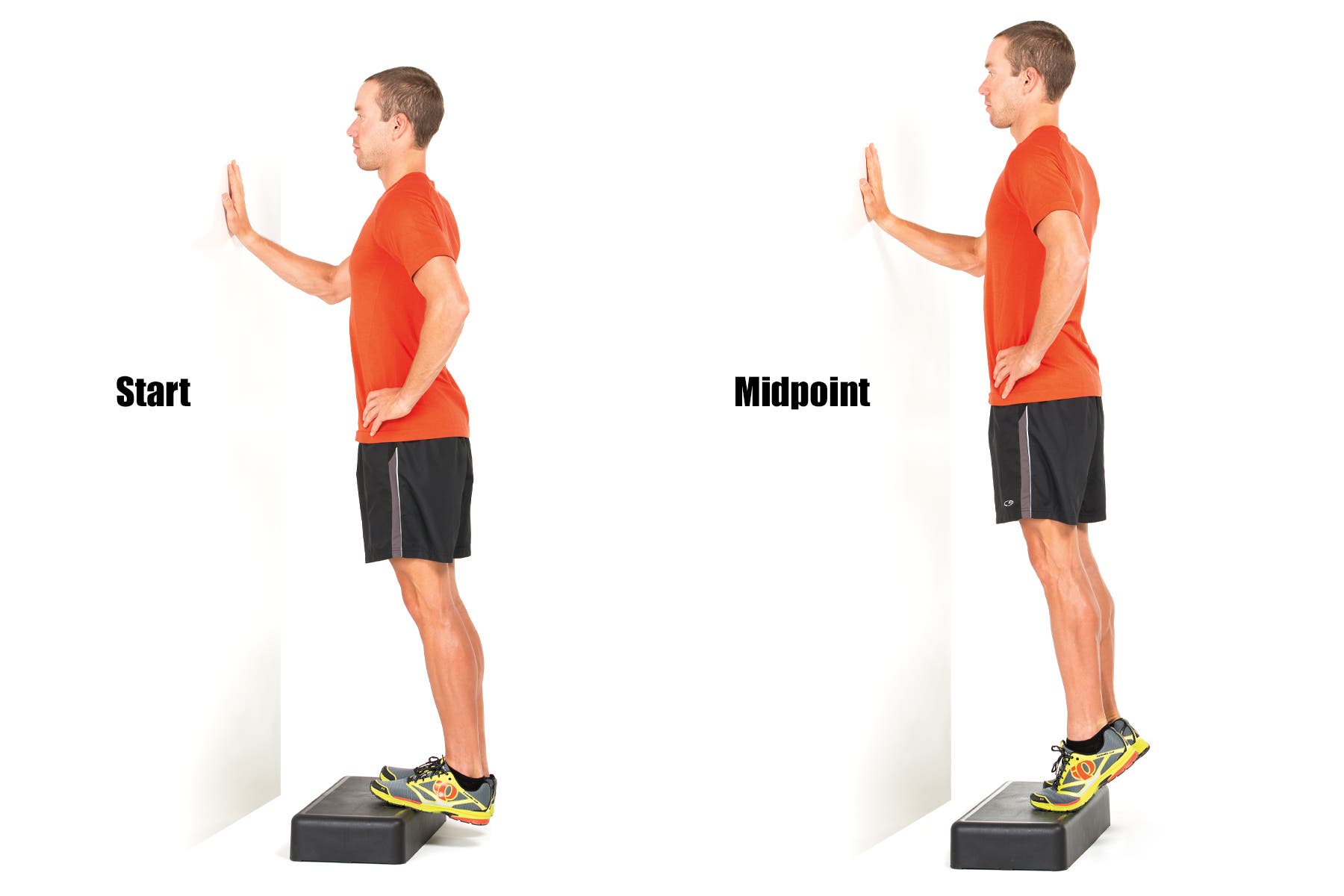
Photo: Jeff Nelson
In the standing calf raise you will work both the soleus and the gastrocnemius muscles of the calf. The gastrocnemius provides more power to your kick and helps the soleus.
Stand with your legs together. You can do this exercise standing flat on the floor, but by standing on the edge of a step, curb, aerobics bench, or even a piece of wood, you will get a larger range of motion and better results. If you use a step, stand on the very edge of it so just the balls of your feet are on it and let your heels hang over the edge (see start). Hold on to something in front of you for support.
Let your heels drop as far toward the floor as possible, then push up on the balls of your feet until you can’t go any higher (see midpoint). Be sure both legs are pushing evenly; don’t let one leg do all the work. Slowly lower your heels back toward the floor and repeat until your set is finished.
Lying Leg Lift
Muscle Focus: gluteus medius
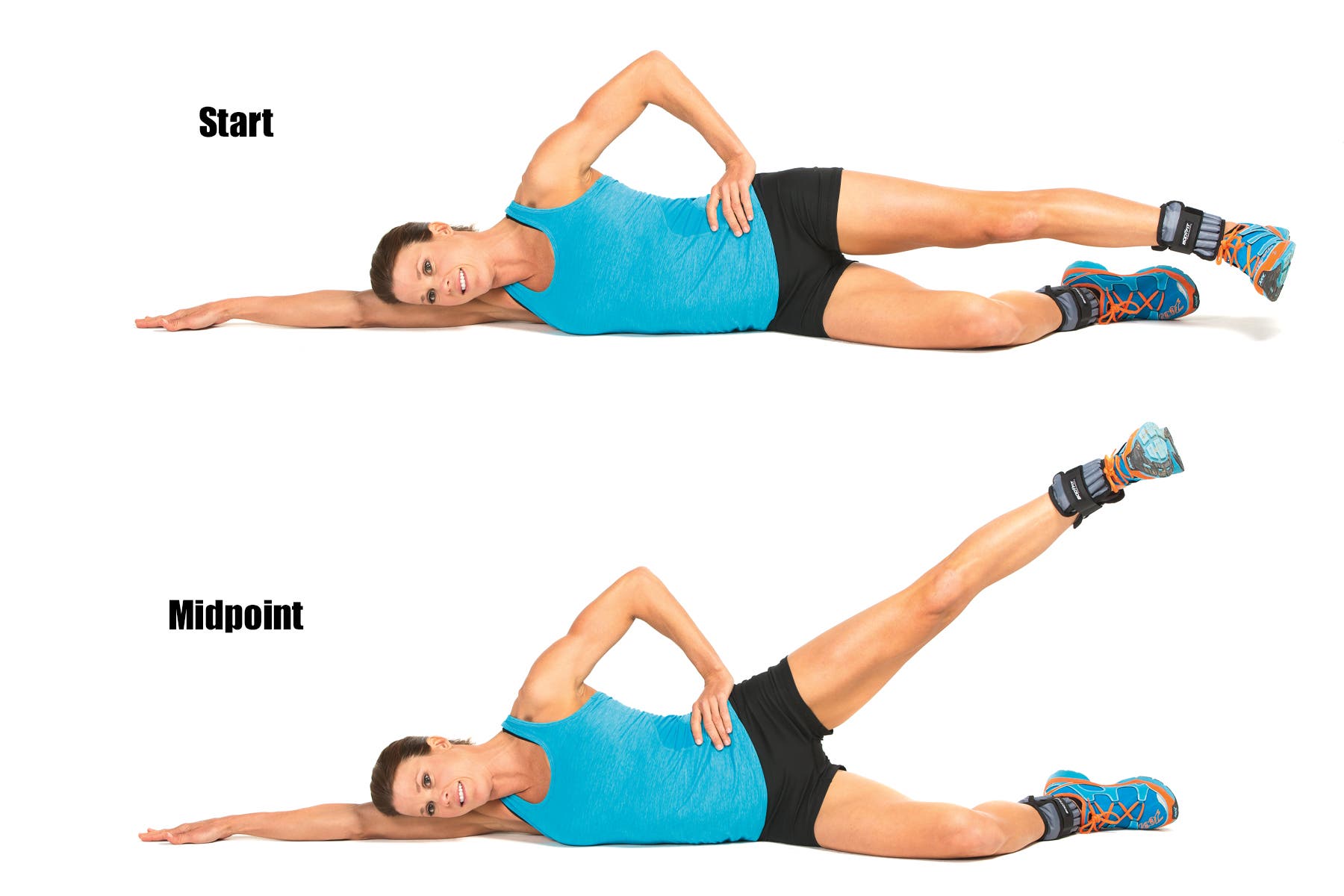
Photo: Jeff Nelson
This exercise targets the smaller glute muscle, the gluteus medius, which is responsible for lifting your leg out to the side. While you don’t make that particular movement much while swimming, this muscle also assists in stabilizing the hip and assists the other glute muscles. Strengthening it will provide more power to each kick.
Attach an ankle weight to the leg you want to work first. Lie on your side on the floor with that leg on top. Position your bottom arm (the one on the floor) straight out over your head, and rest your head on it. Do not prop yourself up on your elbow. Bend your bottom leg (the one on the floor) so your knee is in front of your body and your foot is behind you. This will provide a solid foundation to keep you upright. Your free hand (the top hand) should rest on your hip or waist. Don’t place this hand on the floor, because you will end up pushing against it instead of relying on your glutes for support. Hold your upper leg completely straight, just off the ground (see start), and relax your foot (it doesn’t help to point your toe).
Slowly lift your top leg into the air as far as you can (see midpoint). Do not use momentum or thrust your leg up into the air; you should be in complete control and be able to stop moving at any time, so move slowly. Once you have lifted the leg as far as you possibly can, slowly lower it back down toward the floor, stopping just before you make contact. Don’t let the lifting leg touch down; keep the resistance throughout the full set. Complete your reps, then move the ankle weight to the other leg and complete a set on that side.
Lateral Lunge
Muscle Focus: glutes, hamstrings, quads
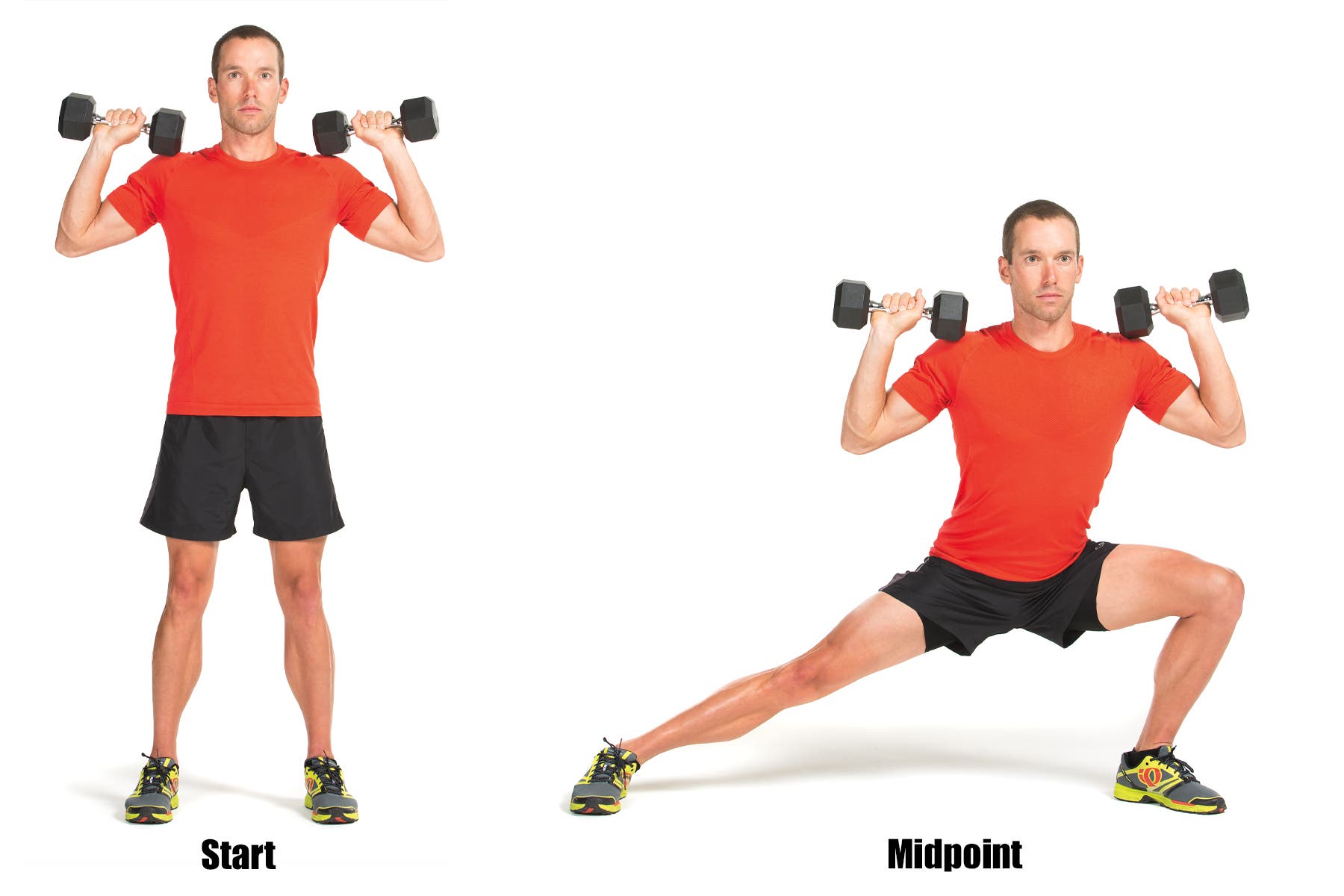
Photo: Jeff Nelson
This exercise has a very large eccentric component that targets all of the leg muscles, making them stronger without using much weight. It combines several movements used in swimming (knee and hip extension, hip adduction, plantar flexion) so you get a great all-around leg exercise.
Stand with your feet slightly apart, with your toes pointed slightly out. Hold a pair of dumbbells at shoulder height (see start), but if it’s too intense, ditch the dumbbells and place your hands on your hips.
Take a giant step out directly to one side while keeping the opposite foot in place. When your stepping foot lands, put all your weight on that foot and bend your knee. Drop into the lunge until your thigh is parallel to the floor. If you can’t bend deep enough to be parallel, just go as far as is comfortable. Your supporting leg should remain straight (see midpoint). Push up out of the lunge to propel yourself back to the starting position. Don’t push so hard that you lose your balance, but push hard enough that you don’t have to take an additional step or drag your foot back to the starting point. Repeat the lunge to the other side, and alternate reps from side to side until the set is complete.
Caution: This exercise can be hard on the knees if you don’t take a big enough step or if you bend too deeply. When you drop down into the lunge, don’t allow your knee to move laterally past your toes. Also, if your heel lifts off the ground, you didn’t step out wide enough. Take a bigger step on your next rep.
Prone Extension
Muscle Focus: glutes
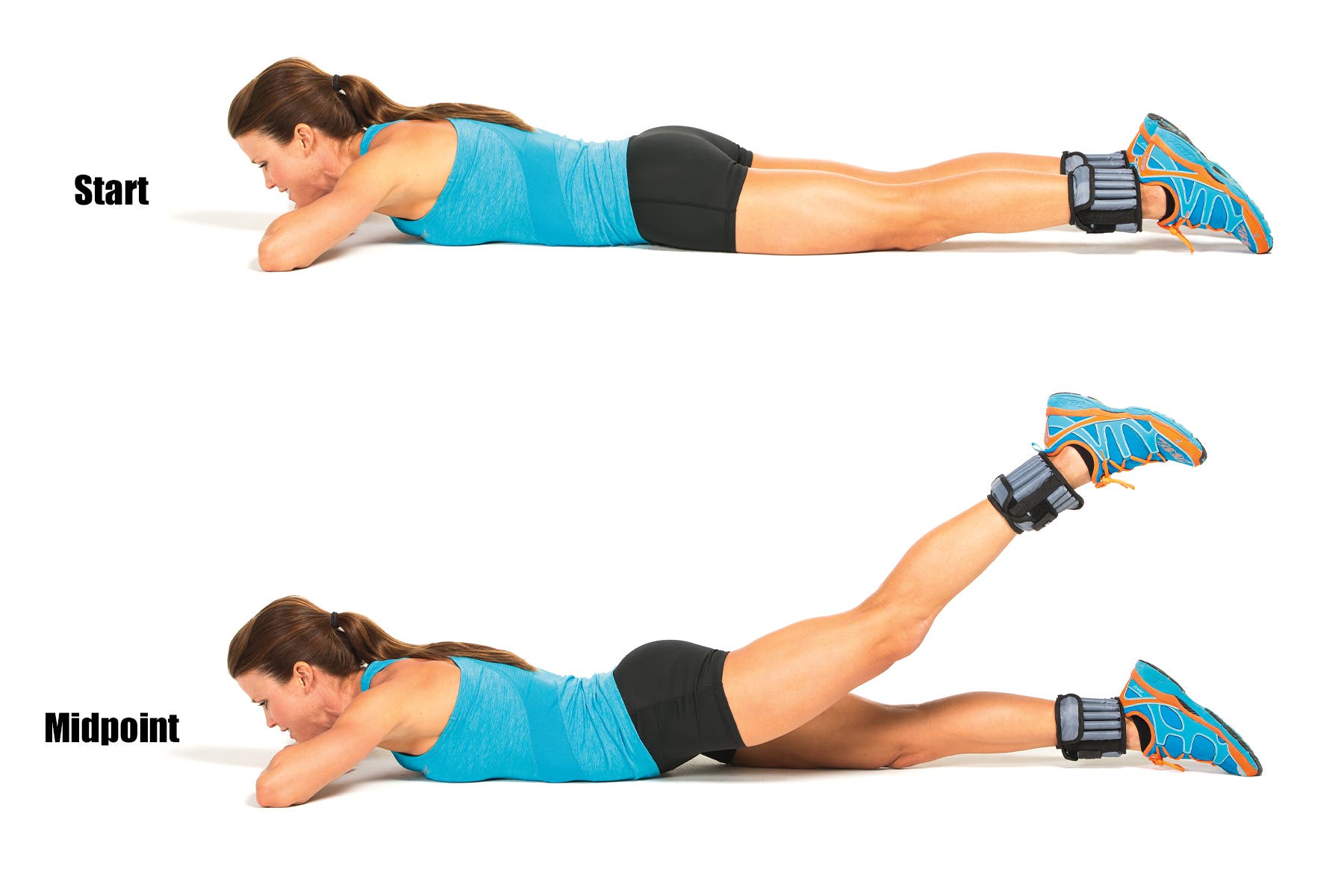
Photo: Jeff Nelson
Attach ankle weights to your legs and lie facedown on the floor. You can lie with your chin on your folded arms for more comfort. Place your feet together, with your legs straight and your toes pointed toward the ground (see start).
Keep one leg on the floor while you lift the other leg as high as you can without rolling your body or lifting your hip off the ground (see midpoint). Contract your glutes to hold your leg up for a count of 3 seconds. Then lower your foot back to the floor, but just as it touches, lift it back up again. Don’t rest between reps. Switch to the other leg and complete the same number of reps to finish your set.
Adapted from Strength Training for Triathletes, 2nd edition, by Patrick Hagerman, with permission of VeloPress.